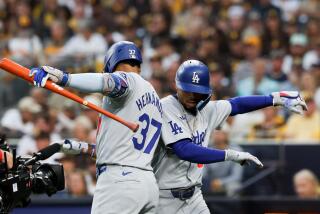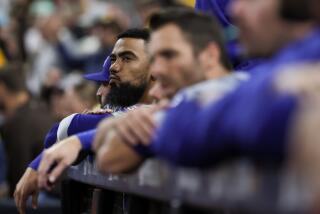Padres Spoil Own Rally in Ninth; Reds Win, 8-7
- Share via
CINCINNATI — They cannot run far enough or fast enough. They can turn the corner until they are dizzy, they can get over all the humps in Egypt, and they cannot get away.
Here it is, two days shy of August, and the spring of 1987 will not leave the Padres alone.
The Padres are no longer the worst team in baseball. Actually since June 4, they are the best team in their division.
And the better they get, the worse it gets.
Tuesday against the best team in their division, the Cincinnati Reds, and against the best left-handed relief pitcher in their league, John Franco, the Padres came back from a three-run ninth-inning deficit Tuesday night to tie the game at 7-7.
Ten minutes later, with two outs in the bottom of the ninth, Padre reliever Goose Gossage threw a ball underneath the chin of Red rookie Lloyd McClendon on a 3-and-2 pitch with the bases loaded.
Ball four, and guess what? No room. McClendon ran to first, and Terry McGriff trotted from third and stomped on home plate with both feet. The Padres were left with their most frequent postgame companion--a disbelieving stare--as they lost, 8-7, in front of 24,209 at Riverfront Stadium.
Great comeback: “Maybe the best this season,” said Padre outfielder Carmelo Martinez.
But what a blowup: “You cannot lose a game like that,” said Gossage.
If a man who walks in the winning run could ever be placed in the neighborhood of “blameless,” it is Gossage. After all, he only faced and messed up on one batter.
When he entered with two outs in the ninth, Gossage inherited the kind of ruins that the Padres can’t seem to avoid. He inherited a runner who had been hit by a pitch with two outs, and a runner whose certain groundout wasn’t a groundout and, well . . .
“We made a million mistakes,” said Manager Larry Bowa.
“We were lucky to even still be in the game.”
Reliever Mark Davis had taken over for the Padres in the bottom of the ninth, and he immediately struck out Dave Parker on four pitches.
Having entered the game on a streak of seven scoreless appearances (12 innings), Davis appeared headed toward more of the same.
He retired pinch-hitter Tracy Jones on a popout to second base and went 0-and-1 on Bo Diaz, but . . . his second pitch hit Diaz in the foot.
“Obviously not where I wanted it,” said Davis. “He got one foot out of the way, but couldn’t get two.”
McGriff ran for Diaz, and next up was Nick Esasky, who had driven in two runs with a double in the sixth. Pitching coach Galen Cisco trotted to the mound and told Davis not to let Esasky beat him. Davis promptly threw four straight balls, putting runners on first and second for Kurt Stillwell.
On Davis’ third pitch, Stillwell bounced the ball to third baseman Chris Brown, who was nursing a sore wrist but was summoned into the game in the ninth for defensive purposes. Finally, extra innings. Or so everyone thought.
After catching the grounder, instead of stepping on third to force McGriff, Brown decided to throw to first. But it had been a slow bounce. And somehow, even with his average speed, Stillwell beat the throw.
“He was right next to third, all he had to do was touch third,” said Bowa. “From where I saw it, he could have tripped over the bag.”
“I had to back up on the ball,” explained Brown, “and I had decided if that was the case, I had to throw to first. If it had been hit right at me, I would have gone to third. If it was hit to my left, I would have gone to second. I thought the man was out.”
In came Gossage and to the plate came McClendon, hitting .176, with only 51 at-bats in 32 games. Gossage threw a strike, then a ball, then a foul ball, then two more balls. McClendon fouled a pitch to the left, and one to the right, and then took ball four for the game-winner.
“It’s easy when the ball is up around your chin,” said McClendon.
“I couldn’t get the breaking ball over,” said Gossage. “I get the breaking ball over, he’s dead. But I get in, it’s ball four, and that’s the game.”
He let out a frustrated laugh. It was appropriate on a night the Padres laughed until they cried.
They scored three runs even before the Reds had a chance to hit, on a first-inning two-run double by Randy Ready and RBI single by Benito Santiago.
But the Reds scored once in the first and four times in the sixth, then added single runs in the seventh and eighth. The Padres scored one run in the eighth, then came back in the ninth against Franco, who had started the season with 10 hitless innings and has had 10 saves, 4 wins and a 1.25 ERA in the Reds’ last 25 victories.
“He’s one of the best relievers in baseball, and we really battled him hard,” said Bowa, shaking his head.
With one out against Franco, Garry Templeton drew a walk. Pinch-hitter Shane Mack then went to 0-and-2 before singling to center, moving Templeton to second. Time for another pinch-hitter, Bruce Bochy, who lined a 1-and-0 pitch to center to score Templeton.
After Stanley Jefferson’s grounder forced Bochy at second, Tony Gwynn hit Franco’s first pitch to the wall for a two-run double and a tie game.
“I don’t know what I hit,” said Gwynn. “He’s the best left-hander in the league, he throws nothing straight, I break my bat and get two bases and I don’t believe it.”
At times, Bowa couldn’t believe it. That rally should have won the game.
“This is the best team in our division, and we are giving them too many outs, too many chances,” he said. “You can’t do that here.”
Like in the sixth, after Esasky doubled in two runs over the head of left fielder Martinez. Esasky tried for third on the play, and was safe when third baseman Luis Salazar dropped a relay. It would have been the third out of a three-run inning. Instead, Stillwell followed with an RBI double to make it a four-run inning.
Or how about the base-running blunder that killed the Padres’ seventh and eighth. In the seventh, with two out, pinch-hitter James Steels singled up the middle. For whatever reason, he tried to steal second, even with the top of the order up. He was thrown out to end the inning.
In the eighth, after the Padres had scored on John Kruk’s single and had runners on first and third with one out, Ready lined a ball to second baseman Stillwell. He caught it for one out, and Kruk was doubled off first after straying too far, ending the inning.
“Now you can see,” said Bowa, “why they are first and we are last.”
Padre Notes
Third baseman Chris Brown came to Riverfront Stadium early for extra batting practice, but his sore right wrist, which caused him to miss the series with Pittsburgh, was still painful enough to keep him from starting for a fifth straight game. He was used defensively in the ninth, however. “I’ve still got a nagging pain; it was just too painful to continue,” said Brown. It’s becoming just as painful for Padres management, which is somewhat miffed because Brown’s recent bone scan showed no sign of a fracture. Brown had a history of nagging hurts and missed days with his former team, the San Francisco Giants, but last season, when one of those ‘nagging pains’ resulted in surgery on a partially detached shoulder tendon, the criticism finally stopped. “He wants to play, but all I know is, the wrist X-rays were negative,” said Manager Larry Bowa of Brown’s current ailment. “It’s up to him. I don’t know what he’s telling you, but he says he can’t swing. That’s all I have to go on.” Brown wasn’t helped by a conversation with Carmelo Martinez, who told him of his 1985 spring woes, when he had a sore wrist, although doctors could find no fracture. It turned out that there was a break in a tiny bone in his hand that required surgery. “I didn’t tell him that was wrong with him,” said Martinez. “I just told him my X-rays didn’t show anything, either. I know he wants to play. But with his X-rays negative, I know what they (management) are thinking. Chris’ best weapon is his bat, and if he’s not able to swing like he can, why go out there?” Said Brown: “I don’t want to get out there and try to play, then have to miss another game, and that kind of thing. I don’t think they want that. I hope they understand.”
At least the Padres can replace Brown with a hot-hitting Randy Ready or Luis Salazar. They have no backup starting pitchers. Starter Andy Hawkins phoned the club Monday before the team plane left for Cincinnati and asked for a re-examination of his sore right shoulder, previously diagnosed as tendinitis. In his loss to Pittsburgh Saturday, he had virtually no velocity. Throwing pitches that barely broke 80 m.p.h., he allowed the first five batters he faced to score, lasting only 1 innings, giving up six runs on five hits. Deciding it wasn’t worth continuing to pitch through the pain, he will remain home at least through the series with the Reds, undergoing therapy and tests and treatments of cortisone at the Scripps Clinic. Jimmy Jones will start in his spot on Wednesday, and a decision will be made on Hawkins’ immediate future by the time the club reaches Houston Friday. Look for him to become the 10th Padre on the disabled list this season. Because there’s no one nearby to take Hawkins’ place, and because they have four off-days in a current stretch of 19 games, the Padres will switch to a four-man rotation of Mark Grant, Eric Show, Ed Whitson and Jones.
More to Read
Go beyond the scoreboard
Get the latest on L.A.'s teams in the daily Sports Report newsletter.
You may occasionally receive promotional content from the Los Angeles Times.











